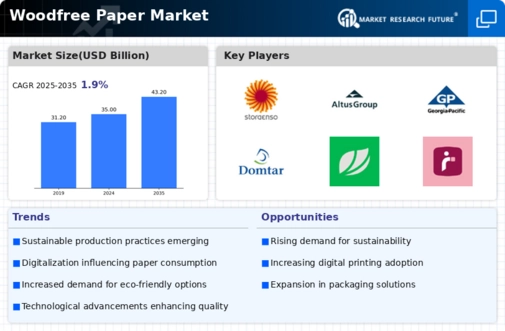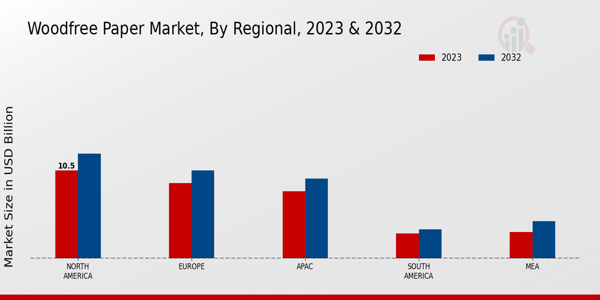Regulatory Frameworks
Regulatory frameworks significantly influence the Global Woodfree Paper Market Industry. Governments worldwide are implementing stricter regulations regarding deforestation and sustainable forestry practices. Compliance with these regulations is essential for manufacturers, as non-compliance can lead to penalties and loss of market access. This regulatory environment encourages companies to adopt sustainable sourcing practices and invest in certifications that demonstrate their commitment to environmental stewardship. As a result, the industry may experience a shift towards more sustainable production methods, which could enhance market stability and growth prospects.
Sustainable Practices
The Global Woodfree Paper Market Industry is increasingly influenced by the shift towards sustainable practices. As consumers and businesses alike prioritize eco-friendly products, manufacturers are adapting their processes to meet these demands. This trend is evident in the rising use of recycled materials and sustainable sourcing of wood fibers. For instance, companies are investing in technologies that reduce waste and energy consumption during production. This commitment to sustainability not only enhances brand reputation but also aligns with global environmental goals, potentially driving market growth as consumers gravitate towards greener options.
Digital Transformation
The ongoing digital transformation is reshaping the Global Woodfree Paper Market Industry. While digital media consumption rises, there remains a substantial demand for printed materials in various sectors, including education and marketing. Businesses are leveraging digital platforms to enhance their outreach while still relying on traditional paper products for tangible marketing collateral. This dual approach suggests a balanced coexistence of digital and print media, which may stabilize demand for woodfree paper. As companies adapt to this transformation, they are likely to innovate their product offerings to cater to both digital and print needs.
Technological Advancements
Technological advancements play a pivotal role in shaping the Global Woodfree Paper Market Industry. Innovations in production techniques, such as digital printing and automated processes, enhance efficiency and reduce costs. These advancements allow manufacturers to produce high-quality paper with lower energy consumption and waste. For example, the integration of artificial intelligence in production lines can optimize resource allocation and minimize downtime. As these technologies continue to evolve, they are likely to attract investment and improve competitiveness within the market, contributing to a projected market value of 35.0 USD Billion in 2024.
Market Trends and Forecasts
Growing Demand in Emerging Markets
Emerging markets are becoming increasingly significant for the Global Woodfree Paper Market Industry. Rapid urbanization and economic growth in regions such as Asia-Pacific and Latin America are driving demand for paper products. As disposable incomes rise, consumers are more inclined to purchase printed materials, packaging, and stationery. This trend is reflected in the projected market growth, with an expected increase to 43.2 USD Billion by 2035. Companies are strategically positioning themselves to tap into these markets, recognizing the potential for sustained demand as literacy rates improve and educational resources expand.














